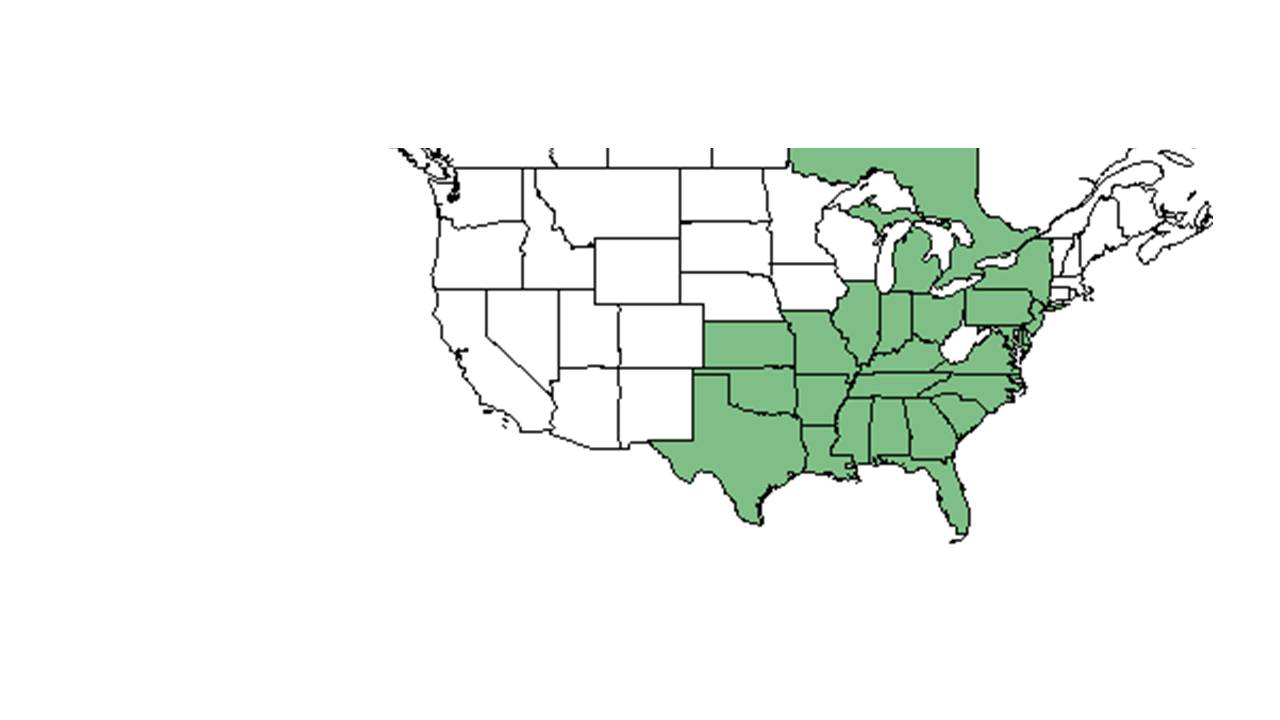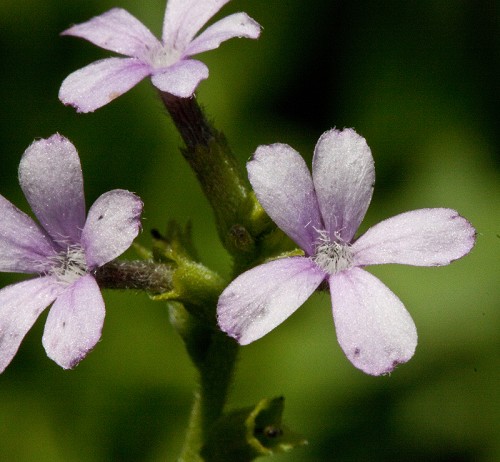Difference between revisions of "Buchnera floridana"
HaleighJoM (talk | contribs) (→Ecology) |
|||
| Line 38: | Line 38: | ||
General habitats are pine savannas, seepage bogs, flatwoods, and sandy roadsides.<ref name= "Weakley">Weakley, A. S. (2015). Flora of the Southern and Mid-Atlantic States. Chapel Hill, NC, University of North Carolina Herbarium.</ref> Other habitats include low lying swamp and sandy acidic pine and palm barrens.<ref name="hear">[[http://www.hear.org/pier/species/buchnera_floridana.htm]]</ref> This species has been observed in Everglades National Park.<ref name="fsu">Florida State University Robert K. Godfrey Herbarium database. URL: http://herbarium.bio.fsu.edu. Last accessed: June 2014. Collectors: V. I. Sullivan and J. Wooten. States and Counties: Florida: Monroe.</ref> | General habitats are pine savannas, seepage bogs, flatwoods, and sandy roadsides.<ref name= "Weakley">Weakley, A. S. (2015). Flora of the Southern and Mid-Atlantic States. Chapel Hill, NC, University of North Carolina Herbarium.</ref> Other habitats include low lying swamp and sandy acidic pine and palm barrens.<ref name="hear">[[http://www.hear.org/pier/species/buchnera_floridana.htm]]</ref> This species has been observed in Everglades National Park.<ref name="fsu">Florida State University Robert K. Godfrey Herbarium database. URL: http://herbarium.bio.fsu.edu. Last accessed: June 2014. Collectors: V. I. Sullivan and J. Wooten. States and Counties: Florida: Monroe.</ref> | ||
| − | ===Phenology=== <!--Timing off flowering, fruiting | + | ===Phenology=== <!--Timing off flowering, fruiting, and environmental triggers. Cite PanFlora website if appropriate: http://www.gilnelson.com/PanFlora/ --> |
''B. floridana'' flowers and fruits all year.<ref name="fsu"/> Flowers are blue-violet or white and bisexual with a superior ovary. | ''B. floridana'' flowers and fruits all year.<ref name="fsu"/> Flowers are blue-violet or white and bisexual with a superior ovary. | ||
| + | |||
<!--===Seed dispersal===--> | <!--===Seed dispersal===--> | ||
<!--===Seed bank and germination===--> | <!--===Seed bank and germination===--> | ||
| Line 46: | Line 47: | ||
Thrives in fire-maintained pine graminoid ecosystems in strongly acidic soils.<ref name="flora"/> | Thrives in fire-maintained pine graminoid ecosystems in strongly acidic soils.<ref name="flora"/> | ||
| − | ===Pollination and | + | <!--===Pollination===--> |
| + | |||
| + | ===Herbivory and toxicology===<!--Herbivory, granivory, insect hosting, etc.--> | ||
''B. floridana'' is noted to have poor forage value.<ref name= "Hilman">Hilmon, J. B. (1964). "Plants of the Caloosa Experimental Range " U.S. Forest Service Research Paper SE-12 </ref> It is a host plant of ''Brevipalpus phoenicis'', which vectors viral diseases like citrus leprosis.<ref name="childers">Childers, C. C., J. C. V. Rodrigues, et al. (2003). "Host plants of Brevipalpus californicus, B. obovatus, and B. phoenicis (Acari: Tenuipalpidae) and their potential involvement in the spread of viral diseases vectored by these mites." Experimental & Applied Acarology 30: 29-105.</ref> | ''B. floridana'' is noted to have poor forage value.<ref name= "Hilman">Hilmon, J. B. (1964). "Plants of the Caloosa Experimental Range " U.S. Forest Service Research Paper SE-12 </ref> It is a host plant of ''Brevipalpus phoenicis'', which vectors viral diseases like citrus leprosis.<ref name="childers">Childers, C. C., J. C. V. Rodrigues, et al. (2003). "Host plants of Brevipalpus californicus, B. obovatus, and B. phoenicis (Acari: Tenuipalpidae) and their potential involvement in the spread of viral diseases vectored by these mites." Experimental & Applied Acarology 30: 29-105.</ref> | ||
| + | |||
<!--===Diseases and parasites===--> | <!--===Diseases and parasites===--> | ||
Revision as of 20:10, 15 June 2022
| Buchnera floridana | |
|---|---|

| |
| Photo by John R. Gwaltney, Southeastern Flora.com | |
| Scientific classification | |
| Kingdom: | Plantae |
| Division: | Magnoliophyta - Flowering plants |
| Class: | Magnoliopsida - Dicotyledons |
| Order: | Scrophulariales |
| Family: | Scrophulariaceae |
| Genus: | Buchnera |
| Species: | B. floridana |
| Binomial name | |
| Buchnera floridana L. | |

| |
| Natural range of Buchnera floridana from USDA NRCS Plants Database. | |
Common names: Florida Bluehearts; Savanna Bluehearts
Contents
Taxonomic notes
Synonyms: Buchnera americana Linnaeus; B. longifolia Swartz (by misattribution); B. breviflora Pennell (by misattribution); B. elongata Swartz.[1]
Varieties: none.[1]
Description
The genus Buchnera are hairy perennials with erect, simple stems growing between 40 - 80 cm tall. The entire plant turns black when dried. The leaves are oppositely arranged, elliptic to ovate-lanceolate in shape, entire or irregularly serrate, and grow up to 3 - 7 cm long and 5 - 15 mm wide, and is reduced above. The inflorescence is an open spike with the flowers in the axils of opposite bracts and supported by 2 bractlets. The 3.5 - 5 mm long calyx tube is cylindrical with lobes 5, lanceolate in shape, slightly unequal, up to 1 mm or less long. The bilaterally symmetrical flowers are purple or white in color and form a tube with 5 petals bent abruptly at right angles. Up to 4 fertile stamens are present with anthers with only a single sac. The 5 - 6 mm capsule seed is ovoid or pyriform.[2]
Specifically, for Buchnera floridana, the leaves are not 3-veined or not as conspicuous are B. americana. The leaves are lanceolate to elliptic in shape. The flower tube grows up to 8 - 10 mm long and the petals grow up to 4 - 5 mm long.[2]
Distribution
Mostly restricted to the coastal plain.[3]
Ecology
Habitat
General habitats are pine savannas, seepage bogs, flatwoods, and sandy roadsides.[4] Other habitats include low lying swamp and sandy acidic pine and palm barrens.[5] This species has been observed in Everglades National Park.[6]
Phenology
B. floridana flowers and fruits all year.[6] Flowers are blue-violet or white and bisexual with a superior ovary.
Fire ecology
Thrives in fire-maintained pine graminoid ecosystems in strongly acidic soils.[3]
Herbivory and toxicology
B. floridana is noted to have poor forage value.[7] It is a host plant of Brevipalpus phoenicis, which vectors viral diseases like citrus leprosis.[8]
Conservation, cultivation, and restoration
Cultural use
Photo Gallery
Flowers of Buchnera floridana Photo by John R. Gwaltney, Southeastern Flora.com
Plant of Buchnera floridana Photo by John R. Gwaltney, Southeastern Flora.com
References and notes
- ↑ 1.0 1.1 Weakley, A.S. 2015. Flora of the southern and mid-atlantic states. Working Draft of 21 May 2015. University of North Carolina at Chapel Hill, Chapel Hill, North Carolina.
- ↑ 2.0 2.1 Radford, Albert E., Harry E. Ahles, and C. Ritchie Bell. Manual of the Vascular Flora of the Carolinas. 1964, 1968. The University of North Carolina Press. 954-5. Print.
- ↑ 3.0 3.1 [[1]]Accessed: April 4, 2016
- ↑ Weakley, A. S. (2015). Flora of the Southern and Mid-Atlantic States. Chapel Hill, NC, University of North Carolina Herbarium.
- ↑ [[2]]
- ↑ 6.0 6.1 Florida State University Robert K. Godfrey Herbarium database. URL: http://herbarium.bio.fsu.edu. Last accessed: June 2014. Collectors: V. I. Sullivan and J. Wooten. States and Counties: Florida: Monroe.
- ↑ Hilmon, J. B. (1964). "Plants of the Caloosa Experimental Range " U.S. Forest Service Research Paper SE-12
- ↑ Childers, C. C., J. C. V. Rodrigues, et al. (2003). "Host plants of Brevipalpus californicus, B. obovatus, and B. phoenicis (Acari: Tenuipalpidae) and their potential involvement in the spread of viral diseases vectored by these mites." Experimental & Applied Acarology 30: 29-105.

